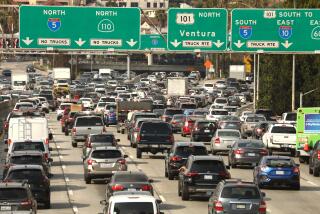Modest Proposal : Car-Sharing, Not Pooling, Is the Answer
- Share via
If you’re a typical commuter, you probably didn’t notice much difference between today’s rush hour traffic and the post-nuclear scene in “Terminator 2,” where all the traffic grinds to a dead halt. For all the time we spend in traffic lock, we might as well be dead to the world.
If only we could get people to double up on their way to work, what a wonderful transportation system we could have. It would dwarf the success of the Blue Line and make our massive freeway system true arteries of speed and convenience.
Unfortunately, anyone who has tried car pools knows why they fail. You lose control over your work hours, you can’t drop your kids off at school, you can’t have emergencies, and you entrust your schedule to others who have their own priorities, not to mention their own driving habits. Perhaps even more important, you lose that quiet time between home and work.
There is a way, however, that we can make car sharing nearly as regular, hassle-free and impersonal as the Blue Line. And in the process we can free up our freeways.
Why not create a volunteer jitney system, one which operates from key pickup and drop-off points along densely traveled commuting routes? It could work like this: Bill commutes from the San Fernando Valley to Downtown Los Angeles. Each morning he drives to the edge of the Valley and a free parking lot. There, a line of cars is waiting, each driven by another commuter going downtown.
Bill joins a line of waiting passengers, pays $3 to an attendant and takes the next available seat in a car. Even at $3 one way, the cost is cheaper than the $8 that Bill pays for parking plus the daily $13 it costs him for fuel and the wear-and-tear on his car to make the 32-mile round trip.
Bill can catch a ride anytime between 6 a.m. and 9 a.m., and at peak times, he can even pick a car playing the news or his brand of music or even a silent car. To make sure everyone has a ride, a bus takes the latecomers at 9 a.m. if no cars are left.
Using a car-pool lane, the volunteer driver reaches a downtown parking structure in 20 minutes. From there, shuttle buses can take Bill to a number of locations, including the subway and light-rail systems.
In the evening, Bill can arrive at the downtown parking structure anytime between 5 p.m. and 7 p.m. and there will be a car waiting to fill up with passengers who live along a certain route. And just like in the morning, a bus can provide backup service at 7 or 7:30.
A typical volunteer driver on Bill’s route is Debby. She is paid a dollar per passenger and parks for free downtown so long as she comes to the morning pickup location between 6 a.m. and 9 a.m. to collect a voucher. To qualify, Debby must be certified by the agency that administers the jitney program. She must have a car in good condition, a good driving record and paid-up insurance. Her certification could be lifted if passengers complain about her driving or if she has obnoxious habits, like spitting out the window. For security, Debby can refuse to take any passenger. Likewise, Bill can hold out for the next driver.
Obviously, to make a system like this work, government agencies would have to get behind it and legislation would have to protect both insurance companies and drivers. An agency would have to administer the program, which would cost money. But it wouldn’t cost the billions of dollars we are pouring into our fixed-rail systems. And we wouldn’t have to wait years for it.
With some inspired marketing, there’s no reason why we couldn’t get commuters to try the jitney system in large numbers. True, there is no natural constituency to sponsor it politically other than the commuters themselves. However, it makes ride-sharing an accessible, convenient and economic alternative. And unless we try it, or something similar, we’ll spend years of our lives on the freeways, like stand-ins in science fiction movies.
More to Read
Sign up for Essential California
The most important California stories and recommendations in your inbox every morning.
You may occasionally receive promotional content from the Los Angeles Times.













